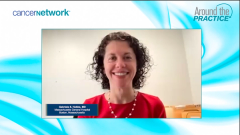
Biomarkers in Myelofibrosis: LDH, BMF, and Triple-Negative Disease
Key opinion leaders in myelofibrosis management reflect on the role of biomarkers in informing treatment selection, even for patients with triple-negative disease.
Episodes in this series

Transcript:
John O. Mascarenhas, MD: If we move away from molecular markers, are there any other biomarkers that might be helpful? It’s well known in Florida that Andrew is very keen on LDH [lactate dehydrogenase]. I want to get a sense how you integrate monitoring LDH in the treatment of patients with MPNs [myeloproliferative neoplasms].
Andrew T. Kuykendall, MD: This is mainly done in Florida. Hopefully the rest of the states will get behind us at some point. When you think about LDH, this generic marker could be looked at as a measure of a hypoxic state or cell turnover to some degree. Within myelofibrosis [MF] and within MPNs, LDH can help you differentiate between things like essential thrombocythemia and myelofibrosis. When you get more hypercellular marrows, you get more cellular turnover and you start to get elevated LDH. Across the board, LDH by itself doesn’t help much. However, there are times when you see a baseline LDH that’s very high. That makes you think that maybe there’s a lot more going on to this disease at the … level than you otherwise thought. You might see a change in LDH in a specific patient: someone who’d been running at an LDH that’s 2 to 3 times the upper limit of normal goes to 6 to 7 times the upper limit of normal. It may make you think that the disease is changing or there’s something else going on. We saw this a lot during COVID-19. With COVID-19 infections or vaccines, LDH levels would go up transiently soon after the vaccine was given and then tapered off toward a more normal level. When that accompanied changes in the numbers, you had to realize that maybe there was some other influence. LDH can be helpful to clue you in to some change in the disease or in some exogenous factor that’s causing it, but it has to be taken into context.
John O. Mascarenhas, MD: Excellent. What about a biomarker like bone marrow fibrosis, is there any value in repeating that bone marrow after a certain interval on a JAK inhibitor? If that fibrosis grade goes down, does that have any clinical impact?
Andrew T. Kuykendall, MD: That 1 is a little tougher because there are a lot of problems with bone marrow fibrosis. It’s the hallmark of the disease. It’s called myelofibrosis because of that bone marrow fibrosis, and we see the scar tissue. When we look at large studies retrospectively, we can see that there’s some prognostic significance to fibrosis. When looked at in large populations, the more you have, the worse the prognosis. If you have less fibrosis, maybe not. On an individual patient level, it’s difficult to understand the value. If a patient goes from moderate to mild fibrosis, is that a change in their underlying disease, a sampling change, or something that isn’t truly related? Dr Steve Oh from Washington University presented the data on fibrosis changes in response to JAK inhibitors, suggesting that maybe they don’t correlate with outcomes.
On the flip side, we see fibrosis go away when patients get stem cell transplants. That reflects the disease being cured in those patients. It may come down to the treatments or the way we’re getting improvements in fibrosis and the degree. When you look at the paper presented by Steve, you’re getting fibrosis changes over the course of 6 months. That might not be a relevant timeline to look at fibrosis changes. With JAK inhibitors, that’s not what we’re expecting to see as true disease-modifying agents. But if we got more disease-modifying agents and looked over time frames of 1, 2, 3 years, maybe we could see a change of clinical relevance to fibrosis over that time period.
John O. Mascarenhas, MD: I totally agree. We’ve been talking about genomics and other biomarkers, and we’ve all mentioned that there are 3 classic driver mutations, JAK2 V617F, calreticulin, and MPL, or thrombopoietin receptor–associated mutation. But there’s a group of patients, at least 10%, who are triple negative and lack these driver mutations. They’re presumably driven by the same JAK-STAT activation pathway, but we may not recognize what’s activating that pathway in those patients. Kristen, do you want to highlight the triple-negative population?
Kristen M. Pettit, MD: The triple-negative population is tricky. When I see a patient with triple-negative MF, my first step is to make sure I’m clear on the diagnosis and that it’s not something else that’s causing fibrosis in the marrow. Not everything that causes marrow fibrosis is myelofibrosis—for example, MDS [myelodysplastic syndrome] with fibrosis, CML [chronic myeloid leukemia] with fibrosis, autoimmune myelofibrosis. Those things are important to rule out, which can sometimes be easier said than done. But based on the bone marrow morphology and usually the presence of other cytogenetic or molecular mutations, we’re confident about the diagnosis of triple-negative MF. Those patients tend to have a rougher course. They tend to be more difficult to treat and [have] a bit more aggressive disease. Finding triple-negative MF makes me think more about the possibility of transplant earlier rather than later, even though triple-negative status isn’t 1 thing that’s worked into most of our prognostic scoring systems.
John O. Mascarenhas, MD: Similarly, with driver mutations and the use of JAK inhibitors, is there any reason why you wouldn’t use a JAK inhibitor in triple-negative patient?
Kristen M. Pettit, MD: No. There’s no reason why you would avoid the JAK inhibitor. I agree with what Gabby said earlier, that I make my JAK inhibitor vs no JAK inhibitor decision based on the presence of symptoms and symptomatic splenomegaly and not the driver mutation status. That said, some factors can correlate with response or lack of response to JAK inhibitors. For example, some of the RAS pathway mutations have been associated with resistance JAK inhibitors. It doesn’t play into my decision of whether to use the agent, but it changes my monitoring and counseling of the patient before we get started with the agent.
Transcript edited for clarity.
Newsletter
Stay up to date on recent advances in the multidisciplinary approach to cancer.











